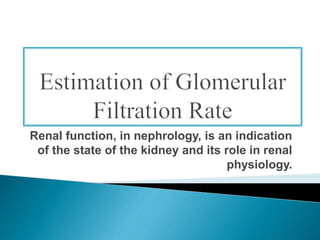Estimation of glomerular filtration rate
•Download as PPTX, PDF•
44 likes•11,880 views
Estimation of glomerular filtration rate
Report
Share
Report
Share

Recommended
More Related Content
What's hot
What's hot (20)
Autoregulation of glomerular filtration rate and renal blood

Autoregulation of glomerular filtration rate and renal blood
Renal physiology, renal blood flow, autoregulation, golmerular filtration. hu...

Renal physiology, renal blood flow, autoregulation, golmerular filtration. hu...
Biochemical kidney function tests with their clinical applications

Biochemical kidney function tests with their clinical applications
Viewers also liked
Viewers also liked (20)
Gfr(glomerulur) filtration rate and its regulation

Gfr(glomerulur) filtration rate and its regulation
Mineral and Bone Disorder in Chronic Kidney Disease

Mineral and Bone Disorder in Chronic Kidney Disease
Similar to Estimation of glomerular filtration rate
Similar to Estimation of glomerular filtration rate (20)
Kidney function tests used in clinical pathology.ppt

Kidney function tests used in clinical pathology.ppt
GFR ,plasma load,clearence,ACR,CCR,eGFR by dr.Tasnim

GFR ,plasma load,clearence,ACR,CCR,eGFR by dr.Tasnim
More from Arun Raj
More from Arun Raj (20)
Recently uploaded
Recently uploaded (20)
Jaipur Call Girls 9257276172 Call Girl in Jaipur Rajasthan

Jaipur Call Girls 9257276172 Call Girl in Jaipur Rajasthan
Hubli Call Girls 👙 6297143586 👙 Genuine WhatsApp Number for Real Meet

Hubli Call Girls 👙 6297143586 👙 Genuine WhatsApp Number for Real Meet
Bhagalpur Call Girls 👙 6297143586 👙 Genuine WhatsApp Number for Real Meet

Bhagalpur Call Girls 👙 6297143586 👙 Genuine WhatsApp Number for Real Meet
palanpur Call Girls 👙 6297143586 👙 Genuine WhatsApp Number for Real Meet

palanpur Call Girls 👙 6297143586 👙 Genuine WhatsApp Number for Real Meet
coimbatore Call Girls 👙 6297143586 👙 Genuine WhatsApp Number for Real Meet

coimbatore Call Girls 👙 6297143586 👙 Genuine WhatsApp Number for Real Meet
VIP Call Girls Noida Sia 9711199171 High Class Call Girl Near Me

VIP Call Girls Noida Sia 9711199171 High Class Call Girl Near Me
VIP Call Girls Noida Jhanvi 9711199171 Best VIP Call Girls Near Me

VIP Call Girls Noida Jhanvi 9711199171 Best VIP Call Girls Near Me
Tirupati Call Girls 👙 6297143586 👙 Genuine WhatsApp Number for Real Meet

Tirupati Call Girls 👙 6297143586 👙 Genuine WhatsApp Number for Real Meet
Call Girls in Udaipur Girija Udaipur Call Girl ✔ VQRWTO ❤️ 100% offer with...

Call Girls in Udaipur Girija Udaipur Call Girl ✔ VQRWTO ❤️ 100% offer with...
Call Girls Hyderabad Just Call 9907093804 Top Class Call Girl Service Available

Call Girls Hyderabad Just Call 9907093804 Top Class Call Girl Service Available
bhubaneswar Call Girls 👙 6297143586 👙 Genuine WhatsApp Number for Real Meet

bhubaneswar Call Girls 👙 6297143586 👙 Genuine WhatsApp Number for Real Meet
Call Girl in Bangalore 9632137771 {LowPrice} ❤️ (Navya) Bangalore Call Girls ...

Call Girl in Bangalore 9632137771 {LowPrice} ❤️ (Navya) Bangalore Call Girls ...
Thrissur Call Girls 👙 6297143586 👙 Genuine WhatsApp Number for Real Meet

Thrissur Call Girls 👙 6297143586 👙 Genuine WhatsApp Number for Real Meet
Dehradun Call Girls 8854095900 Call Girl in Dehradun Uttrakhand

Dehradun Call Girls 8854095900 Call Girl in Dehradun Uttrakhand
Russian Call Girls in Noida Pallavi 9711199171 High Class Call Girl Near Me

Russian Call Girls in Noida Pallavi 9711199171 High Class Call Girl Near Me
Nanded Call Girls 👙 6297143586 👙 Genuine WhatsApp Number for Real Meet

Nanded Call Girls 👙 6297143586 👙 Genuine WhatsApp Number for Real Meet
raisen Call Girls 👙 6297143586 👙 Genuine WhatsApp Number for Real Meet

raisen Call Girls 👙 6297143586 👙 Genuine WhatsApp Number for Real Meet
Patna Call Girls 👙 6297143586 👙 Genuine WhatsApp Number for Real Meet

Patna Call Girls 👙 6297143586 👙 Genuine WhatsApp Number for Real Meet
💚 Punjabi Call Girls In Chandigarh 💯Lucky 🔝8868886958🔝Call Girl In Chandigarh

💚 Punjabi Call Girls In Chandigarh 💯Lucky 🔝8868886958🔝Call Girl In Chandigarh
Estimation of glomerular filtration rate
- 1. Renal function, in nephrology, is an indication of the state of the kidney and its role in renal physiology.
- 2. It is the volume of fluid filtered from the renal Glomerular capillaries into the Bowman's capsule per unit time.
- 3. It is calculated by measuring any chemical that has a steady level in the blood, and is freely filtered but neither reabsorbed nor secreted by the kidneys GFR is typically recorded in units of volume per time.
- 7. Serum creatinine level are used in measuring GFR. is produced naturally by the body. It is freely filtered by the glomerulus. But it is actively secreted by the peritubular capillaries in very small amounts so creatinine clearance overestimates actual GFR by 10-20%
- 8. Problems with creatinine (varying muscle mass, recent meat ingestion, etc.) have led to evaluation of alternative agents for estimation of GFR
- 9. The GFR can be determined by injecting inulin into the plasma. its rate of excretion is directly proportional to the rate of filtration of water and solutes across the Glomerular filter. In early stage renal disease, the inulin clearance may remain normal due to hyper filtration in the remaining nephrons Incomplete urine collection is an important source of error in inulin clearance measurement.
- 10. Protein secreted by most cells in the body that is freely filtered at the glomerulus and not reabsorbed equations have been developed linking estimated GFR to serum cystatin C levels
- 11. One method of determining GFR from creatinine is to collect urine (usually for 24-hours) to determine the amount of creatinine that was removed from the blood over a given time interval. Creatinine clearance (CCr) is calculated from the creatinine concentration in the collected urine sample (UCr), urine flow rate (V), and the plasma concentration (PCr).
- 13. Example: A person has a plasma creatinine concentration of 0.01 mg/ml and in 1 hour produces 60ml of urine with a creatinine concentration of 1.25 mg/mL.
- 16. http://www.nlm.nih.gov/medlineplus/ency/article/00 7305.htm http://en.wikipedia.org/wiki/GFR
